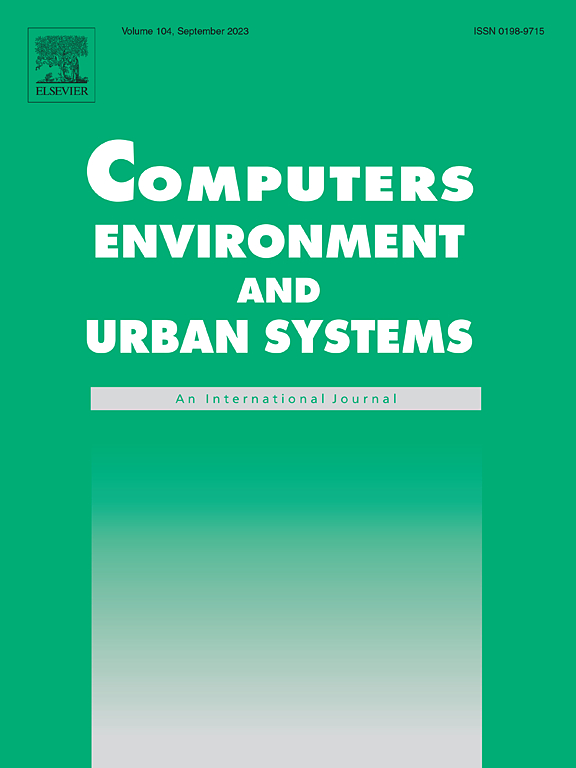Socio-spatial segregation and human mobility: A review of empirical evidence
IF 8.3
1区 地球科学
Q1 ENVIRONMENTAL STUDIES
Computers Environment and Urban Systems
Pub Date : 2025-01-21
DOI:10.1016/j.compenvurbsys.2025.102250
引用次数: 0
Abstract
Socio-spatial segregation is the physical separation of different social, economic, or demographic groups within a geographic space, often resulting in unequal access to resources, services, and opportunities. The literature has traditionally focused on residential segregation, examining how individuals' residential locations are distributed differently across neighborhoods based on various social attributes, e.g., race, ethnicity, and income. However, this approach overlooks the complexity of spatial segregation in people's daily activities, which often extend far beyond residential areas. Since the 2010s, emerging mobility data sources have enabled a new understanding of socio-spatial segregation by considering daily activities such as work, school, shopping, and leisure visits. From traditional surveys to GPS trajectories, diverse data sources reveal that daily mobility can result in spatial segregation levels that differ from those observed in residential segregation. This literature review focuses on three critical questions: (a) What are the strengths and limitations of segregation research incorporating extensive mobility data? (b) How do human mobility patterns relate to individuals' residential vs. experienced segregation levels? and (c) What key factors explain the relationship between one's mobility patterns and experienced segregation? Our literature review enhances the understanding of socio-spatial segregation at the individual level and clarifies core concepts and methodological challenges in the field. Our review explores studies of key themes: segregation, activity space, co-presence, and the built environment. By synthesizing their findings, we aim to offer actionable insights for reducing segregation.
社会空间隔离与人类流动:经验证据综述
社会空间隔离是指地理空间内不同社会、经济或人口群体的物理隔离,通常导致获得资源、服务和机会的不平等。传统上,文献关注的是居住隔离,研究个人的居住地点如何根据不同的社会属性(如种族、民族和收入)在不同的社区中分布。然而,这种方法忽视了人们日常活动中空间隔离的复杂性,这些活动往往远远超出了居民区。自2010年代以来,新兴的流动性数据源通过考虑日常活动(如工作、上学、购物和休闲访问),使人们对社会空间隔离有了新的理解。从传统调查到GPS轨迹,不同的数据来源表明,日常流动性可能导致空间隔离水平不同于在居住隔离中观察到的水平。这篇文献综述集中在三个关键问题上:(a)纳入大量流动性数据的隔离研究的优势和局限性是什么?(b)人口流动模式与个人居住隔离程度和经历隔离程度之间的关系如何?(c)哪些关键因素可以解释一个人的流动模式与经历过的种族隔离之间的关系?我们的文献综述提高了对社会空间隔离在个人层面的理解,并澄清了该领域的核心概念和方法论挑战。我们的综述探讨了关键主题的研究:隔离、活动空间、共存和建筑环境。通过综合他们的发现,我们的目标是为减少种族隔离提供可行的见解。
本文章由计算机程序翻译,如有差异,请以英文原文为准。
求助全文
约1分钟内获得全文
求助全文
来源期刊

Computers Environment and Urban Systems
Multiple-
CiteScore
13.30
自引率
7.40%
发文量
111
审稿时长
32 days
期刊介绍:
Computers, Environment and Urban Systemsis an interdisciplinary journal publishing cutting-edge and innovative computer-based research on environmental and urban systems, that privileges the geospatial perspective. The journal welcomes original high quality scholarship of a theoretical, applied or technological nature, and provides a stimulating presentation of perspectives, research developments, overviews of important new technologies and uses of major computational, information-based, and visualization innovations. Applied and theoretical contributions demonstrate the scope of computer-based analysis fostering a better understanding of environmental and urban systems, their spatial scope and their dynamics.
 求助内容:
求助内容: 应助结果提醒方式:
应助结果提醒方式:


